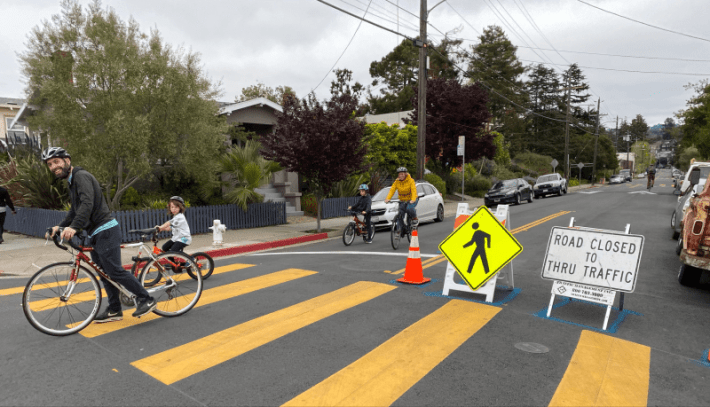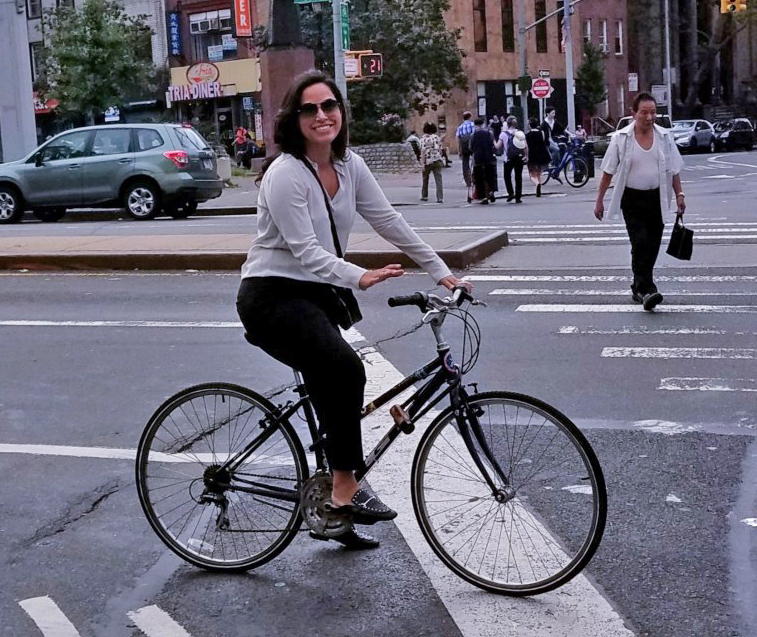Mayor de Blasio will be forced — by law — to open up scores of miles of roadways for pedestrians and cyclists, thanks to a City Council bill that will be introduced next week.
Details of the bill were not provided, but Council Speaker Corey Johnson said in a statement that the goal is to "allocate more street space to pedestrians and cyclists ... with a citywide target of 75 miles of streets."
The proposal, co-sponsored by Manhattan Council Member Carlina Rivera, comes after the mayor's own 1.5-mile open streets pilot collapsed under the weight of the mayor's requirement that it be constantly staffed by numerous police officers at a time when the NYPD itself has been racked by coronavirus in addition to having more important priorities than guarding play streets (all of which was captured in a Streetsblog video parody).
“New Yorkers don’t have the street space they need to maintain proper social distancing, which we know is essential in this public health crisis," Johnson said in a statement that was short on details, but long on quotes from Council supporters (13). "While we want to work collaboratively with the administration to open streets, this issue is so important and so urgent that we are taking legislative action to make it happen ourselves."
That being said, it's past time for members of the City Council to tweet "It's a good idea to open the streets." I'd be curious to see a Council-drafted plan come out publicly
— Good Idea Dave (@DaveCoIon) April 10, 2020
Johnson also alluded to "other cities across the country" that have successfully opened miles and miles of roadway for socially responsible recreation — including Oakland, which has started opening up 74 miles of roadways.

Since the demise of his own 11-day project, the mayor has consistently resisted creating a new way to open up roadway space for non-drivers. He has dismissed the Oakland model as "adamantly" not applicable to New York because we are "denser" than Oakland — though parts of both cities are clearly residential.
The mayor has also steadfastly said he will not open up streets unless he can ensure they will be properly enforced by the NYPD, a standard that no other city maintains. In Oakland and elsewhere, the city's transportation department has handled the open space with little staffing and few resources beyond "road closed" barricades.
Rivera, who cycles to work, was disappointed that de Blasio failed to innovate and lead.
"For years, New York City led the nation in developing innovative solutions to our biggest urban challenges," she said in a statement. "Now we’ve fallen behind so many other cities during the COVID-19 crisis, including when it comes to ensuring proper social distancing on our streets for New Yorkers."
After initial publication of this story, Transportation Alternatives Executive Director put out the following statement.
We applaud the leadership of Council Speaker Johnson and Council Member Rivera for advancing this bold open streets plan that will ensure New Yorkers who must be out have the safe space they require for physical distancing. In doing so, they are proving that New York seeks to lead, not play catch-up with the scores of other cities around the world opening streets to people as this crisis unfolds.
Streets account for roughly 80 percent of New York City’s public space, and their ambitious open streets program will give 75 miles of streets back to people, their rightful owner, when New Yorkers desperately need them. Last month, Transportation Alternatives and Bike New York suggested examples of streets that the city should consider opening to pedestrians.
We call on the City Council and the mayor to implement this plan without delay, and, over time, to expand the program to support the needs of all New Yorkers.
Mayor de Blasio addressed the issue at his morning press conference, saying he would work with the Council, but insisted that NYPD personnel will still be required in big numbers. Here is the mayor's answer in full, edited only to eliminate redundant thoughts:
On this particular issue, the important point for me is safety, health. ... Whatever we do, is it helping us keep New Yorkers safe? The proposal builds on some of the notion of what we've seen in other cities around the country, like Oakland. But [New York has] very different realities. And [other cities'] plans would not work here if adopted in the way they were in other places. So I want to make sure that anything we do with our streets does not put any New Yorkers in danger or create a situation where people think they can walk in the middle of the street but in fact there are still vehicles there. We do not create a situation where emergency vehicles and crucial deliveries can't get through. We do not create a situation where we need to use enforcement personnel we still don't have enough of, drawing them off of other things that are crucial. These are my concerns. I'm going to hold a high bar for that.
[Point of fact: Other cities also have emergency vehicles and crucial deliveries.]






